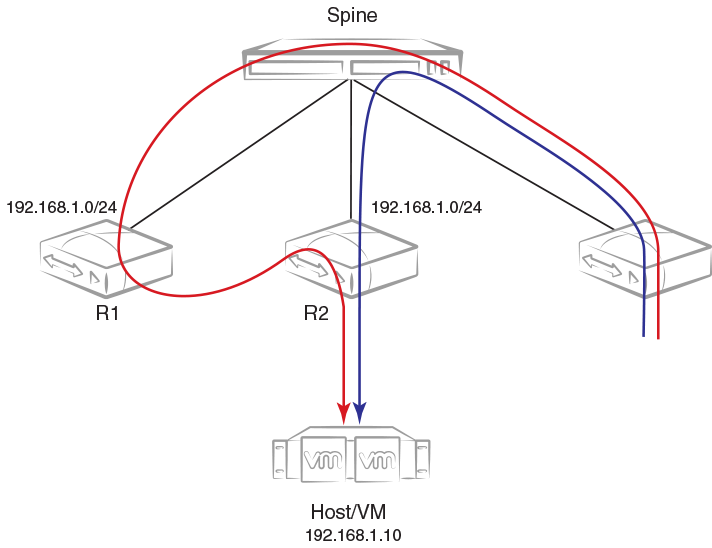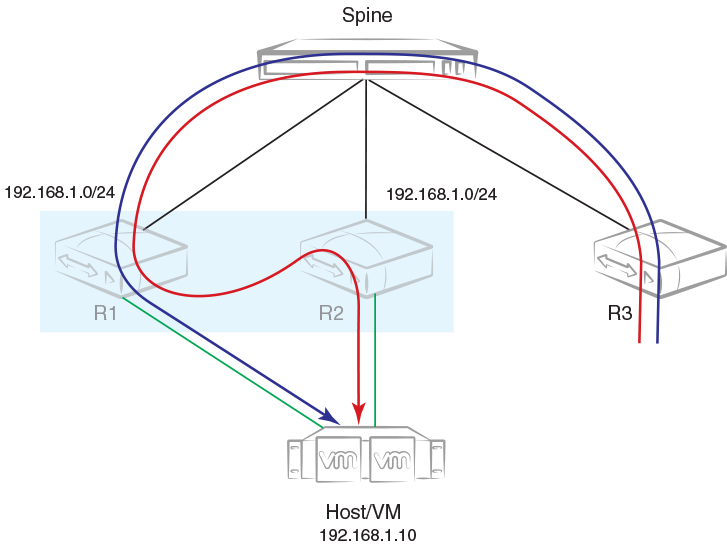EVPN prefix route exchange and Multi-VRF support
Extensions to RFC 7432 to support the advertisement of IP prefix routes are proposed in IETF draft "IP Prefix Advertisement in EVPN."
A new route type, Type-5, is available for exchanging IPv4 and IPv6 prefixes in the overlay network. In a multitenant Layer 3 deployment, each tenant is assigned a VRF. Prefixes in each VRF may be gateway prefixes and prefixes belonging to the tenant, and these are discovered by routing protocols such as BGP and OSPF. In order to exchange prefixes in a VRF, end-to-end routing protocol adjacency in that VRF is required between the routers hosting a given tenant. EVPN prefix route eliminates such a limitation and, similar to IP VPN, can accumulate routes across all VRFs in BGP and allow the per-VRF import of prefixes by routers depending on the route-targets.
IP VPN is MPLS-only technology, whereas EVPN prefix route exchange provides the same functionality over any type of overlay encapsulation type supported by EVPN. Prefix route exchange is supported on the VXLAN and MPLS types of BGP EVPN encapsulation and peering.
For each tenant VRF from which prefixes are required to be exported into EVPN or imported from EVPN, the following configurations are required:
- Configure the VRF import/export route-targets for EVPN
- Select an integrated routing and bridging (IRB) interface in the VRF for routing.
The following example shows VRF RD and RT configurations in IPv4 and IPv6 address-families for the respective import and export of prefixes from and into EVPN.
vrf red rd 100:1 evpn irb ve 10 address-family ipv4 unicast route-target export 100:100 evpn route-target import 100:100 evpn ! address-family ipv6 unicast route-target export 100:200 evpn route-target import 100:200 evpn ! !
The IRB interface is the VE interface that is used for routing after tunnel termination. The IRB interface should belong to the tenant VRF and be administratively up. It is not required to configure an IP address on the IRB interface, as shown in the following configuration example.
interface Ve 10 vrf forwarding red no shutdown !
Depending on the encapsulation, appropriate attributes for overlay are used in the EVPN prefix route advertisement, as shown in the following table.
| Field | Description |
|---|---|
|
Route Distinguisher |
This is configured under IP VRF |
|
ESI |
This is set to 0. |
|
IP Prefix |
This is the gateway or tenant prefix in the VRF. |
|
Gateway IP |
This is set to 0. |
|
MPLS Label |
VXLAN: This is the VNI corresponding to the IRB VE interface. MPLS: This is the IP VRF MPLS label |
Export route-targets are attached to prefixes exported into EVPN. Remote end routers compare configured IP VRF RTs against RTs in the route and, in case of a match, prefix routes are imported into EVPN and then into IP VRF tables. In case RTs in a prefix route match multiple VRFs, routes from the EVPN table are imported into each matching VRF.
After the import into IP VRF, the next-hop resolution of the prefix route is not performed in the VRF. Instead, overlay next-hop is used and the prefix route is programmed with the exit interface as a tunnel.
In the case of VXLAN, the advertising router attaches the MAC address of the IRB interface as part of the MAC extended community of the BGP router in the prefix route. This MAC address is used as the next-hop MAC by the remote routers. In the forwarding plane, after tunnel decapsulation, routing on the inner frame is performed, because the outer DA MAC is the IRB interface MAC.
In the case of MPLS, MAC address of the router is not attached, because the inner VRF label in the frame causes routing in the corresponding VRF.
Symmetric or asymmetric routing
Depending on how VLANs/BDs are extended on the leaf nodes, symmetric or asymmetric routing may be observed. In the case of symmetric routing, routing on a VLAN/BD occurs only at a single router/leaf in the network. On the other hand, when the same VLAN/BD is extended on multiple routers, in the presence of distributed anycast gateway, each leaf node performs routing for traffic entering from local edge ports, causing routing to occur asymmetrically, depending on the direction of traffic.
Import/export route-map filtering
The route-map-based filtering of routes imported into IPVRF or exported into EVPN is supported. An import or export route-map can be applied under IPv4 or IPv6 address-family under a VRF configuration, as shown in the following example configuration.
device(vrf-red-ipv4-unicast)# import map my-import-filter evpn device(vrf-red-ipv4-unicast)# export map my-export-filter evpn
Conversion of MACIP to host route to avoid traffic tromboning
In a typical IP Fabric network where distributed anycast gateway is configured on multiple leaf nodes, the same connected prefix is advertised by multiple nodes. A leaf node that does not extend the same VLAN/BD, but has extended the VRF, imports these prefixes, forms ECMP, and load balances the traffic across the tunnels. Because of ECMP, traffic may take a suboptimal path as shown in the following figure.

In order to avoid the suboptimal forwarding, a router extending the tenant VRF accepts MACIP routes matching the IP VRF RT in the EVPN table and converts those MACIP routes to IPv4 /32 prefix routes or IPv6 /128 or routes and imports them into the IP VRF table.
Anycast/VRRP IPv4 and IPv6 prefix routes are advertised with BGP default gateway extended community.
In the current release, because conversational ARP/ND is not supported, all converted IPv4 /32 host routes are installed in the forwarding plane. On the other hand, even though prefixes are received with default-gateway extended community, they are installed in the forwarding plane as normal prefix routes pointing to the ECMP next-hop.
By default, the conversion of MACIP routes to host routes is enabled. However, it can be disabled by means of the following configuration under BGP EVPN address-family.
router bgp
address-family l2vpn evpn
suppress ipv4 host-route
!
!
Avoiding traffic tromboning in an MCT cluster
In an EVPN VXLAN network, Type-5 prefix routes are advertised by an MCT cluster with a source VTEP IP address that is common within the cluster. Also, each route carries a router-MAC address that is system-MAC unique to an MCT node. The remote node installing the prefix routes advertised by the MCT peer chooses one of the paths in the forwarding plane. However, an intermediate router may further load balance the traffic depending on the destination LVTEP IP address.
In the following figure, traffic towards Host/VM is load balanced by R3 across R1–R2 ECMP paths (the same next-hop but with different router-MAC addresses). However, the same traffic gets load balanced again by Spine across R1 and R2. Because of the underlay load balancing, Layer 3 traffic with the router-MAC of R2 may land on R1 and conversely. Because the destination MAC after VXLAN tunnel termination belongs to the MCT peer, traffic is Layer 2-switched to the MCT peer and is then routed there. This causes traffic tromboning.

This issue is resolved by exchanging the router-MAC address within the MCT cluster and installing the router MAC address of the MCT peer for routing based on the following example configuration.
vrf red evpn irb ve 10 cluster-gateway
When a peer gateway configuration is present for an EVPN IRB VE interface for the VRF, Layer 3 traffic destined for the MCT peer‘s router MAC in the corresponding VLAN/BD is routed locally.

